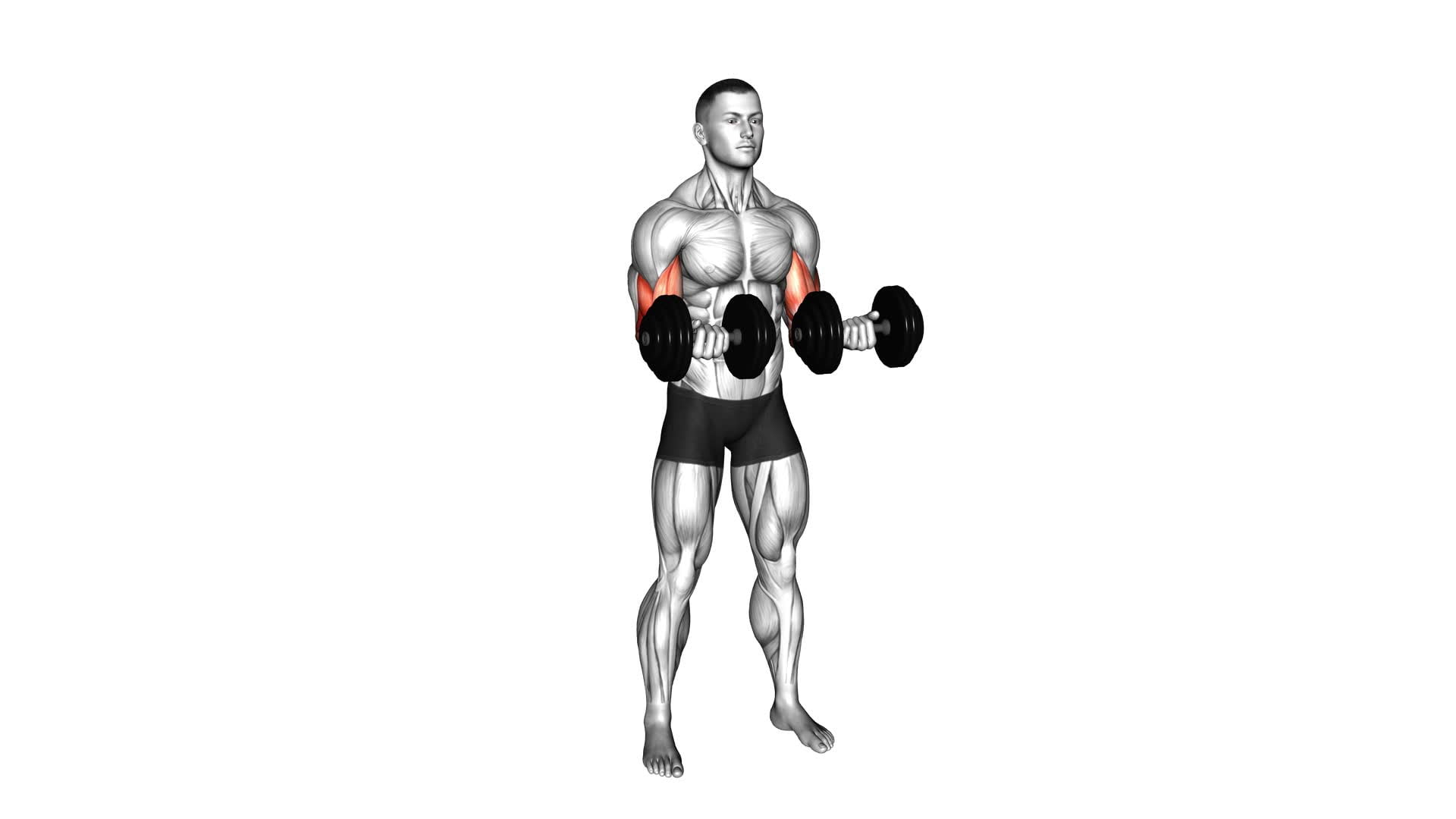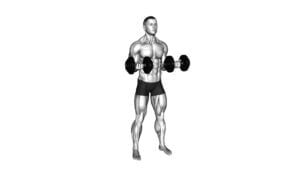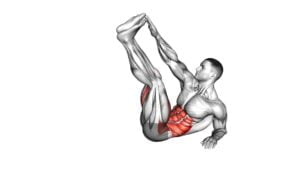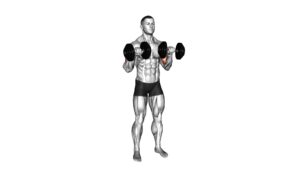Dumbbell Standing Reverse Curl Rotate (male) – Video Exercise Guide & Tips

Looking to strengthen your biceps and improve your upper body strength? Check out this video exercise guide on the dumbbell standing reverse curl rotate.
Watch This Exercise Video
In just a few minutes, you'll learn the proper form and technique for this challenging exercise. Whether you're a beginner or an experienced lifter, there are variations and modifications for every fitness level.
Plus, we'll share some tips to help you get the most out of your workout and avoid common mistakes.
Let's get started!
Key Takeaways
- The Dumbbell Standing Reverse Curl Rotate targets the brachioradialis and brachialis muscles, improving forearm strength and stability.
- This exercise engages different muscles compared to regular curls, leading to enhanced grip strength and defined biceps.
- Maintaining proper arm positioning and avoiding swinging or using momentum is crucial for maximizing effectiveness and minimizing injury risk.
- Controlled movements are important as they prevent momentum, reduce the risk of injury, and target specific muscles, resulting in greater muscle growth and strength gains.
Benefits of the Dumbbell Standing Reverse Curl Rotate
To maximize your upper body strength and build defined biceps, incorporate the Dumbbell Standing Reverse Curl Rotate into your workout routine. This exercise is one of the many dumbbell curl variations that can help you achieve your fitness goals.
The reverse curl, in particular, targets your brachioradialis and brachialis muscles, which are located in your forearm and assist in flexing your elbow joint.
One of the main benefits of reverse curls is that they engage different muscles compared to regular curls. While regular curls primarily target your biceps, reverse curls place more emphasis on your brachioradialis and brachialis muscles. This variation helps to improve overall forearm strength and stability, which is essential for daily activities and sports performance.
In addition to targeting different muscles, the Dumbbell Standing Reverse Curl Rotate also helps to improve grip strength. As you lift the dumbbells and rotate your wrists, your grip is challenged, leading to increased strength and endurance in your hands and forearms.
Incorporating the Dumbbell Standing Reverse Curl Rotate into your workout routine not only helps to build defined biceps but also enhances forearm strength and grip. By adding this exercise to your arsenal of dumbbell curl variations, you can achieve a well-rounded upper body workout and see noticeable results in your overall strength and muscle definition.
Proper Form and Technique for the Exercise
When performing the Dumbbell Standing Reverse Curl Rotate, it's crucial to maintain proper arm positioning throughout the exercise. Keep your elbows tucked in close to your sides and avoid swinging or using momentum to lift the weights.
Focus on controlled movements, lifting the dumbbells up towards your shoulders while maintaining a stable core. By avoiding common mistakes such as excessive swinging or using too much weight, you can maximize the effectiveness of this exercise and minimize the risk of injury.
Arm Positioning During Exercise
Maintain proper arm positioning by keeping your elbows close to your sides during the Dumbbell Standing Reverse Curl Rotate exercise. This is crucial for maintaining proper arm alignment and maximizing muscle activation.
By keeping your elbows close to your sides, you're able to target the biceps and forearms more effectively. This positioning also helps to stabilize your upper body and prevent any unnecessary strain on your shoulders.
It's important to maintain this arm position throughout the entire exercise to ensure proper form and technique. By doing so, you'll be able to perform the exercise with control and precision, which is essential for getting the most out of your workout.
Now let's discuss the importance of controlled movements in this exercise.
Importance of Controlled Movements
You should always perform the Dumbbell Standing Reverse Curl Rotate exercise with controlled movements to ensure proper form and technique. By focusing on controlled movements, you can maximize the effectiveness of this exercise.
Here are some important reasons why controlled movements are crucial:
- Prevents momentum: By maintaining control throughout the exercise, you avoid relying on momentum to lift the dumbbells. This ensures that your muscles are doing the work, leading to better results.
- Reduces the risk of injury: Performing the exercise with controlled movements helps to minimize the risk of injury. It allows you to maintain proper alignment and stability, reducing strain on your joints.
- Targets specific muscles: Controlled movements enable you to target the specific muscles involved in the Dumbbell Standing Reverse Curl Rotate exercise, such as the biceps and forearms.
- Enhances muscle engagement: By focusing on controlled movements, you can increase muscle engagement and activation, leading to greater muscle growth and strength gains.
Common Mistakes to Avoid
To ensure proper form and technique for the Dumbbell Standing Reverse Curl Rotate exercise, it's important to be mindful of common mistakes.
One common mistake is using too much weight, which can compromise your form and increase the risk of injury. It's essential to start with a weight that allows you to maintain proper form throughout the entire movement.
Another mistake is swinging the arms or using momentum to lift the dumbbells. This takes away the focus from the targeted muscles and reduces the effectiveness of the exercise. Instead, concentrate on using controlled movements and engaging the biceps and forearms.
Finally, avoid arching your back or leaning forward during the exercise. Maintain a straight posture to ensure proper alignment and maximize the benefits of the exercise.
Variations and Modifications for Different Fitness Levels
For individuals at different fitness levels, there are various modifications and variations available for the dumbbell standing reverse curl rotate exercise. Here are some options to consider:
- Variations:
- Increase or decrease the weight of the dumbbells to adjust the intensity of the exercise.
- Perform the exercise on one leg to challenge your balance and engage your core muscles.
- Use resistance bands instead of dumbbells to add a different level of resistance.
- Incorporate a stability ball by standing on it while performing the exercise to further challenge your balance and stability.
- Progression:
- Start with lighter weights and gradually increase the load as you become stronger and more comfortable with the exercise.
- Increase the number of repetitions or sets to intensify the workout.
- Slow down the tempo of the exercise to increase time under tension and enhance muscle growth.
- Perform the exercise on an unstable surface, such as a Bosu ball, to further challenge your stability and core strength.
- Modifications:
- If you have wrist pain or discomfort, you can perform the exercise with a neutral grip or use wrist wraps for support.
- If you have limited mobility in your wrists or shoulders, you can perform the exercise using a hammer grip.
- For individuals with lower back issues, perform the exercise seated on a bench or stability ball to reduce strain on the lower back.
- If you're a beginner, start with bodyweight only and focus on mastering the form before adding weights.
By incorporating these variations, progressions, and modifications, you can tailor the dumbbell standing reverse curl rotate exercise to your specific fitness level and goals.
Remember to listen to your body and make adjustments as needed to ensure a safe and effective workout.
Tips for Maximizing the Effectiveness of the Exercise
To maximize the effectiveness of the dumbbell standing reverse curl rotate exercise, it's important to focus on proper form techniques. Keep your back straight, engage your core, and avoid using momentum to lift the weights.
Additionally, pay attention to your breathing during the exercise, exhaling as you curl the weights up and inhaling as you lower them down.
Lastly, consider using different weight variations to challenge your muscles and continue making progress.
Proper Form Techniques
Maximize the effectiveness of the Dumbbell Standing Reverse Curl Rotate exercise with proper form techniques. Here are some tips to help you get the most out of your workout:
- Maintain proper posture throughout the exercise, keeping your back straight and shoulders relaxed.
- Use a controlled motion when lifting the dumbbells, avoiding any jerking or swinging movements.
- Keep your elbows close to your body and use your forearms to rotate the dumbbells.
- Focus on the muscles you're targeting, engaging them fully with each repetition.
By following these proper form techniques, you can minimize the risk of common injuries associated with improper form techniques, such as strained muscles or tendonitis.
Don't fall for common misconceptions about proper form, and remember that technique is key to maximizing the effectiveness of this exercise.
Breathing Techniques During Exercise
Maintain your breathing rhythm throughout the Dumbbell Standing Reverse Curl Rotate exercise to optimize its effectiveness. Proper breathing techniques play a crucial role in maximizing exercise efficiency.
When performing this exercise, inhale as you lower the dumbbells and exhale as you rotate your palms upward. This controlled breathing helps stabilize your core and engage your muscles more effectively.
Breathing deeply and fully allows for increased oxygen intake, enhancing your endurance and overall performance. It also helps prevent dizziness or lightheadedness during the exercise.
Remember to exhale forcefully as you rotate your palms to fully activate your biceps. By focusing on your breathing and synchronizing it with your movements, you can make the most out of the Dumbbell Standing Reverse Curl Rotate exercise.
Recommended Weight Variations
As you continue the exercise, you can enhance its effectiveness by incorporating recommended weight variations. Here are some exercise modifications to consider:
- Increase the weight: Gradually increase the weight of the dumbbells to challenge your muscles and promote strength gains.
- Decrease the weight: If you're struggling with proper form or experiencing discomfort, try using lighter dumbbells to reduce strain on your muscles and joints.
- Use alternating weights: Hold a heavier dumbbell in one hand and a lighter dumbbell in the other to add an element of balance and stability to the exercise.
- Incorporate resistance bands: Attach resistance bands to the dumbbells and perform the exercise to add extra resistance and target your muscles from different angles.
Common Mistakes to Avoid When Performing the Exercise
To avoid common mistakes when performing the Dumbbell Standing Reverse Curl Rotate exercise, you must ensure proper form and technique. One common mistake to avoid is using improper grip on the dumbbells. Make sure to firmly grip the dumbbells with your palms facing down and your fingers wrapped around the handles. This will help you maintain control and stability throughout the exercise.
Another mistake to be aware of is using too much weight. Using weights that are too heavy can lead to poor form and increase the risk of injury. Start with lighter weights and gradually increase as your strength improves.
It's also important to avoid swinging your body during the exercise. Keep your upper arms stationary and engage your biceps to lift the dumbbells, focusing on controlled and smooth movements.
Lastly, make sure to maintain proper posture throughout the exercise. Keep your back straight, shoulders relaxed, and core engaged.
Sample Workout Routine Incorporating the Dumbbell Standing Reverse Curl Rotate
To incorporate the Dumbbell Standing Reverse Curl Rotate into your workout routine, follow these steps for an effective and challenging upper body workout.
- Start with a warm-up: Spend 5-10 minutes doing some light cardio exercises like jogging or jumping jacks to get your heart rate up and your muscles warm.
- Perform 3 sets of 10-12 reps: Grab a pair of dumbbells and stand with your feet shoulder-width apart. Curl the dumbbells up towards your shoulders, rotating your wrists as you lift. Slowly lower the dumbbells back down to the starting position and repeat for the desired number of reps.
- Rest for 30-60 seconds between sets: Take a short break between sets to allow your muscles to recover and prepare for the next set.
- Incorporate the exercise into your upper body routine: Add the Dumbbell Standing Reverse Curl Rotate to your existing upper body routine, performing it 2-3 times per week. This exercise targets your biceps, forearms, and shoulders, so it pairs well with other exercises like push-ups, shoulder presses, and tricep dips.
Frequently Asked Questions
How Many Sets and Reps Should I Do for the Dumbbell Standing Reverse Curl Rotate?
To determine the sets and reps for the dumbbell standing reverse curl rotate, consider your fitness level and goals. Start with 3 sets of 8-12 reps, resting 1-2 minutes between sets.
If you have a previous wrist injury, modify the exercise by using lighter weights or performing the movement with palms facing up.
Always listen to your body and consult with a professional if needed.
Can I Use a Barbell Instead of Dumbbells for This Exercise?
Yes, you can use a barbell instead of dumbbells for the dumbbell standing reverse curl rotate. However, using dumbbells offers certain benefits.
Dumbbell exercises require more stabilization, which helps engage smaller muscles and improve overall balance. Additionally, using dumbbells allows for a greater range of motion, targeting different muscle fibers.
Is It Necessary to Warm up Before Performing the Dumbbell Standing Reverse Curl Rotate?
It's important to warm up before performing the dumbbell standing reverse curl rotate. Warming up helps prepare your muscles for the exercise and reduces the risk of injury.
It increases blood flow, flexibility, and range of motion. Common mistakes to avoid during this exercise include using too much weight, swinging the arms, and not maintaining proper form.
Take the time to warm up and avoid these mistakes for a safer and more effective workout.
Can I Do This Exercise if I Have a Previous Wrist Injury?
If you have a previous wrist injury, modifications can be made to the dumbbell standing reverse curl rotate exercise. Instead of using dumbbells, you can try using resistance bands or a cable machine to reduce strain on your wrists.
Another alternative is to focus on exercises that target the same muscles without putting as much stress on your wrists, such as hammer curls or bicep curls with a barbell.
Always consult with a healthcare professional before starting any new exercises.
How Often Should I Incorporate the Dumbbell Standing Reverse Curl Rotate Into My Workout Routine?
To get the most out of your workout routine, it's important to incorporate the dumbbell standing reverse curl rotate.
This exercise has numerous benefits for your upper body strength and muscle development. By regularly including it in your routine, you can improve your grip strength, forearm muscles, and overall arm definition.
For advanced trainers, there are variations of this exercise that can provide an extra challenge and help you push your limits.
Conclusion
In conclusion, the dumbbell standing reverse curl rotate is a beneficial exercise for improving arm strength and flexibility. By following proper form and technique, individuals can target their biceps and forearms effectively.
Different variations and modifications ensure that people of all fitness levels can participate in this exercise. To maximize effectiveness, it's important to focus on controlled movements and avoid common mistakes.
Incorporating the dumbbell standing reverse curl rotate into a regular workout routine can help individuals achieve their fitness goals.

Author
Years ago, the spark of my life’s passion ignited in my mind the moment I stepped into the local gym for the first time. The inaugural bead of perspiration, the initial endeavor, the very first surge of endorphins, and a sense of pride that washed over me post-workout marked the beginning of my deep-seated interest in strength sports, fitness, and sports nutrition. This very curiosity blossomed rapidly into a profound fascination, propelling me to earn a Master’s degree in Physical Education from the Academy of Physical Education in Krakow, followed by a Sports Manager diploma from the Jagiellonian University. My journey of growth led me to gain more specialized qualifications, such as being a certified personal trainer with a focus on sports dietetics, a lifeguard, and an instructor for wellness and corrective gymnastics. Theoretical knowledge paired seamlessly with practical experience, reinforcing my belief that the transformation of individuals under my guidance was also a reflection of my personal growth. This belief holds true even today. Each day, I strive to push the boundaries and explore new realms. These realms gently elevate me to greater heights. The unique combination of passion for my field and the continuous quest for growth fuels my drive to break new ground.







